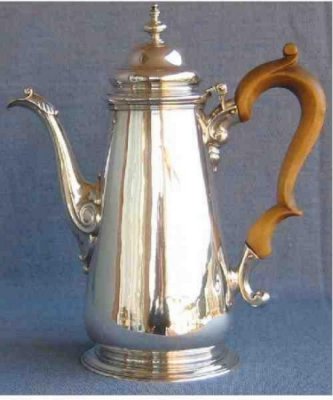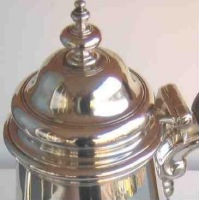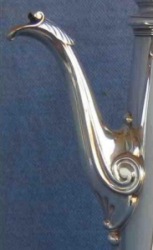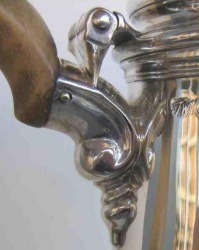click on images to enlarge
TEN STEPS TO VERIFY THE AUTHENTICITY
OF ANTIQUE SILVERWARES
(A practical example concerning a George II English coffee pot)
To verify the authenticity of antique silver isn't an easy task. Of course, a specialist's
opinion in written form may be required purchasing an item in an antique shop.
For a collector who prefers to search and buy items out of the traditional - and sometimes
expensive - antique retailer shops, a valid alternative way is to collect as much
informations as possible about the style evolutions and patterns of the object he intends to buy.
Furthermore it is necessary to adopt a rigorous and pragmatic approach, trying to avoid emotional
factors which may affect the correct evaluation of the item.
As an example we'll try to verify the authenticity of one of the most important pieces of
my collection: an English George II Coffee pot dating 1745.
So, we place the pot on the table and our test through 10 consecutive steps begins .
1. Preliminary evaluation and recording of measures and weight of the item
The first step is a roughly examination of the item, according to its dimension (25 cm tall,
about 10 in.) and weight (820 g, about 29 oz.), as well as the evidence of alterations, research
of base metal different from silver, etc.
From this point of view our coffee pot looks to be a piece of great gauge and quality as anyone
would expect from an English silver of the first half of 18th century.
2. Hallmarks research and their examination (individual and as a set)
 Now we research coffee pot hallmarks. Hallmarks in exposed positions
are often rubbed and difficult to read on antique silver, due to the repeated polishing
of the item. Rubbing of hallmarks positioned in a straight line increases progressively from
the more protected side (in our case the handle) towards the more exposed side at the
centre of the pot.
Now we research coffee pot hallmarks. Hallmarks in exposed positions
are often rubbed and difficult to read on antique silver, due to the repeated polishing
of the item. Rubbing of hallmarks positioned in a straight line increases progressively from
the more protected side (in our case the handle) towards the more exposed side at the
centre of the pot.
This is our case: the first mark, near the handle, is quite clear and corresponds to the maker
mark of the silversmith Thomas Whipham I (note 1), working in London at the middle of
18th century. The second hallmark is slightly rubbed on the upper side, but its bottom
shape allows its attribution to the 14th cycle of London hallmarks (it was used only between
1739 and 1755)
(see http://www.argentinglesi.com/london.php ). In this mark (not well visible) the lion
is looking straight front (this hallmark was used in London until 1820).
The third hallmark is the date letter. This mark is quite rubbed but a 'k' letter in the shape
of the 14th cycle of London hallmarks may be easily seen.
The last hallmark, completely unreadable, should be the crowned leopard head, symbol of the
London assay Office since 1550. Anyway the set of hallmarks clearly certifies that this coffee
pot was marked in London between the May 1745 and the April 1746.
Usually a further help in dating a silver piece is supplied by the marks inside the lid (lion
passant and, often, maker's mark), but our coffee pot has no mark inside the lid.
We record this peculiarity (more explanations later) and we proceed with our test.
|
3. Coherence between hallmarks' date and actual production of the item in this age
In our case the question is: were coffee pots already produced in England in 1745?
The answer is positive, the first known example of an English coffe pot being dated 1681 (George
Garthorne ?, London 1681/2 - Victoria & Albert Museum)
4. Correspondence between hallmarks' date and pattern/shape of the item
Now we check if our coffee pot pattern was common in 1745, George II reigning.
The answer is positive, as this shape and pattern was very popular between
1740 and 1760, the so called 'tuck in base' ( Ian Pickford, 2003.
Starting to Collect Antique Silver - Antiques Collector's Club, and Peter
Waldrom, 2001. The price guide of antique silver. Antiques Collector's
Club).
Furthermore, the coffee pot foot is obtained by 'raising' (working a plain sheet of silver
with the hammer) and not by 'casting', and the 'tuck in base' is not pronounced enough to
give a baluster shape to the body. This means that, likely, this pot was crafted between
1740 and 1750. The shape of the lid (wrapping over the rim, without a
sleeve fitting outside) is typical of the years around the 1745 (Ian Pickford, 2003. Starting to
Collect Antique Silver - Antiques Collector's Club).
Sometimes this particular pattern has no hallmark inside the lid (Ian Pickford, 2003. Starting to
Collect Antique Silver - Antiques Collector's Club).
5. Close examination of pattern details (spout, handle, feet, finial,
etc)
Now we evaluate finishing and decorations.
In the middle of George II' reign, coffee pots had slightly rounded bases,
spouts and handle holders decorated with elegant shell moulding decorations and
fruitwood made handles (ivory insulators for coffee pots were introduced only at
the beginning of the 19th century).
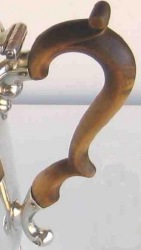
 Silver crafted handles were insulated by wicker or leather coating
(like the cited pot of the Victoria & Albert Museum).
Silver crafted handles were insulated by wicker or leather coating
(like the cited pot of the Victoria & Albert Museum).
Also the finial has a typical shape used at the middle of 18th century.
|
6. Coherence between hallmarks date and the style of the applied decoration
Between 1745 and 1750 the use of 'Rococo style', introduced from France since 1730,
spread on all kind of silverware. 'Rococo style' was also applied to coffee pots, mugs and tankards
(never influenced before by this kind of decoration), but most of this silverware continued to
be crafted on the traditional smooth design named 'Queen Anne'.
Luckily, our coffee pot is one of the latter examples of the use of 'Queen Anne' style
(a 'Rococo' style object would have required a more complicated appraisal).
7. Examination of crafting technology related to date hallmarks
Now we evaluate our coffee pot under a technical point of view, trying
to identify how it was crafted.
In mid 18th century two techniques were used to craft a coffee pot (and
other objects, like teapots, cream jugs, pepper castors and sugar bowls)
(Jan Pickford, 2003. Starting to Collect Antique Silver - Antiques Collector' s Club).
The first one, usually applied by the more appreciated silversmiths, was the 'raising' technique,
which consists in hammering a plane sheet of silver until body's pot was shaped and
high quality items were obtained.
A second technique, applied by a wider number of silversmiths, used a
'raising' technique only for some parts of the pot (the base and the lid) while the body was made
bending a plane sheet of silver, soldering its edges ('seaming') and hammering the cylinder until
the appropriate shape was obtained.
The base was soldered to the body and the handle fitted in the sheet junction to improve its
solidity.

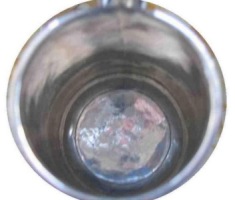 A close inspection of our pot's inside shows its crafting with 'seaming' technique,
with an evident vertical soldering line where fits the handle and a round
soldering line where the base fits.
A close inspection of our pot's inside shows its crafting with 'seaming' technique,
with an evident vertical soldering line where fits the handle and a round
soldering line where the base fits.
The lid was obtained by 'raising' with no soldered parts (apart the finial).
On the pot's inside there are signs of hammering, mainly on the base and inside the lid
obtained by 'raising' or requiring more hammering (where hammer's traces where not smoothed
down).
The spout and handle's supports were obtained by moulding.
Usually the solidity of a 'seamed' item is lower than a 'raised' one,
and its weight varies considerably.
(Ian Pickford, 2003. Starting to Collect Antique Silver - Antiques Collector's Club,
Woodbridge, Suffolk (UK)). In our case, silver gauge is excellent (Thomas Whipham is
recognised as a good and prolific specialist of coffee pots and other hollowware)
(Ian Pickford, 2003. Starting to Collect Antique Silver - Antiques Collector's Club,
Woodbridge, Suffolk - UK).
Another technique for coffee pot crafting was introduced only at the end of 18th
century and consisted in working on a lathe a flat sheet of silver pushing
it against a mould.
This technique (spinning), a follow on of the Industrial Revolution widely applied in 19th
century, smoothes also the pot's inside, avoids soldering and hammering signs
(unless later intentional additions) but produces objects of meagre solidity and weight,
requiring a double hem to reinforce the edge (obviously, 'spinning' technique
may not be applied on a 1745 coffee pot). |
8. Close research of possible forgery or transposition and/or alterations of hallmarks
Some further caution is requested examining items of good weight made in England between 1720 and
1757, owing to 'duty dodging' practices.
In 1720, when 'sterling' standard (925 ppt) was reinstated after
the compulsory use of Britannia standard (958,4 ppt), a
6 pence duty per troy ounce of silver was imposed on silverware production and trade.
An object of about 28 oz (800 gr.) was subject to a duty equalling a 2005 value of about 100/115 dollars,
that is to say the same price requested by a silversmith for a coffee pot manufacture.
The temptation for a silversmith to 'dodge the duty' and keep
this money for himself was consequently very high, in spite of a death sentence imposed
for hallmarks forgery or transposing.
Some dishonest silversmiths used spoons or little salt cellars (paying a small duty
for the standard verification of the Assay Office) cutting their hallmarks and soldering
on pieces of higher weight.
This silversmith's behaviour wasn't a direct fraud for contemporary customers but,
nevertheless, these items are now less collectable and of lower value for modern collectors.
'Duty dodging' requires a close examination of hallmarks.
At that time, coffee pots hallmarks were impressed either in a straight line (just under
the edge of the pot, starting from the handle), or in the base (the maker's mark positioned
in the centre and the others symmetrically impressed around it).
Hallmarks impressed in a straight line under the pot or scattered
around the maker's mark are highly probably the result of 'duty
dodging'.
Usually coffee pots subjected to 'duty dodging' were hallmarked in the base, the best position
to hide soldering signs (if they are impressed in a straight line under the pot they are,
quite surely, taken from a spoon) (note 2).
Sometimes, is easy to identify these forgeries as a line of deeper
colour appears around the transposed hallmarks, owing to the faster oxidizing of the soldering
alloy (it contains a lower amount of silver than the sterling standard).
The best way to evidence this dark outline is to breathe on the hallmark or to heat with a flame.
But, usually, discovering 'duty dodging' isn't an easy task.
A quite perfect technique of 'duty dodging' was to solder under the pot a dish obtained by
hammering an open salt cellar, just at the junction between the base,
the seamed body of the pot and the foot.
This fraud may be evidenced only unsoldering the pedestal and ascertaining the presence of
a double bottom.
Another way is to verify the presence of the so called 'ghost hallmarks'
(the relief left inside the pot by mark's impression).
If the 'ghost hallmarks' correspond to the position of the hallmarks on the outside and there's
no evidence of trasposition, 'duty dodging' may be reasonably excluded.
(obviously the 'duty dodgers' finishing the object may have eliminated the 'wrong ghost hallmarks'
or the plate's thickness may have prevented their presence).(note 3).
A close inspection of our coffee pot may exclude any 'duty dodging' or transposition of hallmarks.
9. Evaluation of the item referring to the presence of any fault, imperfection,
damage or repair
The appeal and the value of an antique silver is strictly related to its overall condition.
Most English silverware were used as household items for many generations and may have been
damaged by this use.
Thus, repairs and restorations of silver are quite common but, even if well executed, they
are disliked by collectors who prefer objects in mint conditions and without repairs
or re-solderings.
Particularly important is to identify additions or substitutions of parts of the item (this practice
was subjected to the obligation of hallmarking only from 1797).
The repaired parts are usually easy to discover owing to the yellowish color of the soldering alloy
(it has a high percentage of copper) or, even, the black color of the lead used in very poor repairs.
In our coffee pot there is only a small repair where the finial joins to the lid.
The presence of dings, dents or small cleaning streaks is not a particularly
detracting factor, unless they compromise the stability and the solidity of the piece.
Now we examine the surface of the pot and its 'patina'.
The surface is smoothed, but over 250 years of cleaning was not so deep as to remove the
wonderful grey colour 'patina' (deep and not appropriate cleaning may affect the appeal and the
value of the item ).
The coffee pot has no coat of arms or sign of its erasure, so our conclusion is that it was
never engraved.
10. Record and documentation of the item
(dimension, weight, maker, style and pattern, date, town, imperfections, damages
and repairs, duty dodging, later additions and any other available information)
Now we may classify the coffee pot as:
English George II coffee pot, crafted in London by the silversmith Thomas Whipham
(maker mark TW in capital italic letters, contained in a punch that follows their outlines).
The pot bears the London hallmarks for 1745/46: lion passant (guarantee of the sterling standard)
and date letter 'k', both in a punch of the typical shape in use from 1739 to 1755. Hallmarks
are partly rubbed and the leopard head (symbol of the London Assay Office) is unreadable.
No mark in the lid (a common practice of this period).
'Tuck in base' pattern used between 1740 and 1750/60. No applied decoration and
coat of arms on the body. Lid wraps over the rim with no sleeve to fit outside.
Fully hand-crafted item: 'seamed' body; lid, foot and base obtained by the raising technique;
shell moulded finial, spout and handle support. Original fruitwood handle.
Dimensions 10 in. (25 cm) high, 4 3/4 in. (12 cm) wide at the base. Weight: 29 oz. (820 gr.)
Excellent conditions, with a couple of minor dents on the base and on the foot not
compromising the stability. Traces of soldering inside the lid where the finial fits,
probably the consequence of an old repair.
No evidence of transposition of hallmarks, later additions or alterations. No evidence
of removal of any coat of arms.
Summarising the steps of our check:
1. preliminary evaluation and recording of measures and weight of the item ;
2. hallmarks research and their examination (individual and as a set);
3. coherence between hallmarks' date and actual production of the item in this age;
4. correspondence between hallmark's date and pattern/shape of the item;
5. close examination of pattern details (spout, handle, feet, finial, etc);
6. coherence between hallmark's date and the style of the applied decoration;
7. examination of crafting technology related to its date hallmarks;
8. close research of possible forgery or transposition and/or alterations of hallmarks ;
9. evaluation of the item referring to the presence of any fault, imperfection, damage or repair;
10.record and documentation of the item .
endnotes:
(1) the maker mark (initials of the first name and the surname) complies with the act of 1739
which was imposed to destroy all the older marks (both those reporting the two first letters of the
surname, in use during the Britannia Standard period, and those used after the repealing of
the sterling standard in 1719/20, reporting the initials of the first name and the surname).
Since 1739, in order to diversify the marks of silversmiths having the same initials, became
usual to register marks in gothic font or written in italic type).
(2) The silversmith decided the positioning of the hallmarks.
When the piece was crafted and before finishing he impressed his mark and the item was sent
to the Assay Office standard control. The silverware returned for finishing after hallmarking.
Some examples of coffee pot with the maker mark underneath and the other ones
positioned in a straight line above the rim has been found. It is not clear if this was
voluntarily done by the Assay Office to reduce the risk of duty dodging.
(3) This finishing was mainly used in sugar bowls or two handled cups, but
seldom it was applied also to coffee pots, which inside was usually not finished with evidence
of hammering and soldering.
References:
Ian Pickford, 1991. Pocket Edition Jackson's Hallmarks: English,
Scottish, Irish Silver and Gold Marks from 1300 to Present Day. Antiques
Collector's Club, Woodbridge, Suffolk (UK)
Charles J. Jackson, 1964. English Goldsmiths and their marks - A
history of the goldsmiths and plate workers of England, Scotland and
Ireland. Second revised Edition. Dover Publications Inc.,
New York.
Seymour B. Wyler, 1937. The Book of Old Silver : English, American,
Foreign. Crown Publisher Inc. New York (USA).
Ian Pickford, 2003. Starting to Collect Antique Silver - Antiques
Collector's Club, Woodbridge, Suffolk (UK).
Peter Waldrom, 2001. The price guide of antique silver. Antiques
Collector's Club, Woodbridge, Suffolk (UK).
Giovanni Ciceri - 2005 -
http://www.argentinglesi.com
English text revised by Douglas Hawkes |

